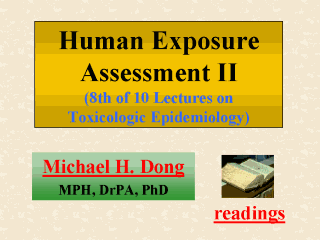| front |1 |2 |3 |4 |5 |6 |7
|8 |9 |10 |11 |12 |13 |14 |15 |16 |17 |18 |19 |20 |21 |22 |23 |24 |review |
 |
This is the
eighth of 10 lectures on toxicologic epidemiology. It is the second of a two-part
presentation on human exposure assessment (HEA), which is a key component of health risk
assessment. The focus of the first part in Lecture 7
was on the use of human biological monitoring as direct measurement methods for assessing
human exposure to environmental contaminants. This second part continues the discussion on HEA, but with a focus on the use of indirect measurement methods (IMM) as assessment tools. The various available IMM are all built upon the premise that [human exposure] = [human contact] x [environmental concentration], regardless of the exposure pathways involved. Also presented in this second part as examples are several exposure assessment models designed to facilitate the required calculations, which in many instances are numerous and complex. This is often the case because many environmental contaminants are omnipresent, and exposure to them can be via many routes of entry. The titles of the 10 lectures are: (1) Toxicology and Epidemiology; (2) Public Health and Risk Assessment; (3) Toxicology and Risk Assessment; (4) Epidemiology and Risk Assessment; (5) Toxicologic Side of Epidemiology; (6) Epidemiologic Side of Toxicology; (7) Human Exposure Assessment I; (8) Human Exposure Assessment II; (9) Characterization of Health Risk; and (10) Toxicologic Epidemiology. |